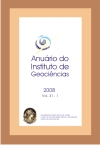Bioavailability of mercury, zinc and copper in distinct grain sizes of a contaminated soil using earthworms Eisenia andrei
DOI:
https://doi.org/10.11137/2008_2_33-41Abstract
The scientific community has been concerned about heavy metals contamination and their effects on human health and the environment. Rural areas of Descoberto municipality, southern Minas Gerais State, were submitted to gold extraction using rudimentary techniques of mineral processing. In 2002, local population detected metallic mercury presence on soil surface, and in 2005 Environmental Foundation of Minas Gerais State (FEAM) delimited a critical contamination area. This works proposes bioavailability assessment of mercury (Hg), zinc (Zn) and copper (Cu) in distinct grain sizes of a soil sample collected into the critical area delimited by FEAM. Granulometric analysis was done using nylon sieves of 200 # (75 µm), 100 # (150 µm), 80 # (180 µm), 42 # (350 µm) and 10 # (1700 µm). Mineralogical characterization was executed using X-ray difratometry. Earthworms acute toxicity test follows ASTM (2004) procedures. Metals determination in soil and earthworms was performed using Atomic Absorption technique. Methylmercury (MeHg) quantification was made using Gas Chromatography. Grain sizes analysis showed sand predominance. Total chemical analysis demonstrated a very high level of contamination of Hg, Zn and Cu, confirming previous studies executed by FEAM. It was observed an affinity between grain size and metals concentrations, which is related to increasing specific surface. Acute toxicity test denoted that earthworms absorbed Hg and Cu from the soil, and Zn uptake involved absorption and bioaccumulation for smaller grain sizes. Total chemical analysis of metals in earthworms revealed that finer granulometric intervals showed higher levels of heavy metals bioavaibility. MeHg quantification denoted concentrations about 21 a 33% of total Hg. In conclusion, it is expected that these results can give an important support for future decisions in medical geology programs and in environmental control actionsDownloads
Published
2008-12-01
Issue
Section
não definida
License
This journal is licensed under a Creative Commons — Attribution 4.0 International — CC BY 4.0, which permits use, distribution and reproduction in any medium, provided the original work is properly cited.
















 Except where otherwise noted, content on this site is licensed under a license
Except where otherwise noted, content on this site is licensed under a license 